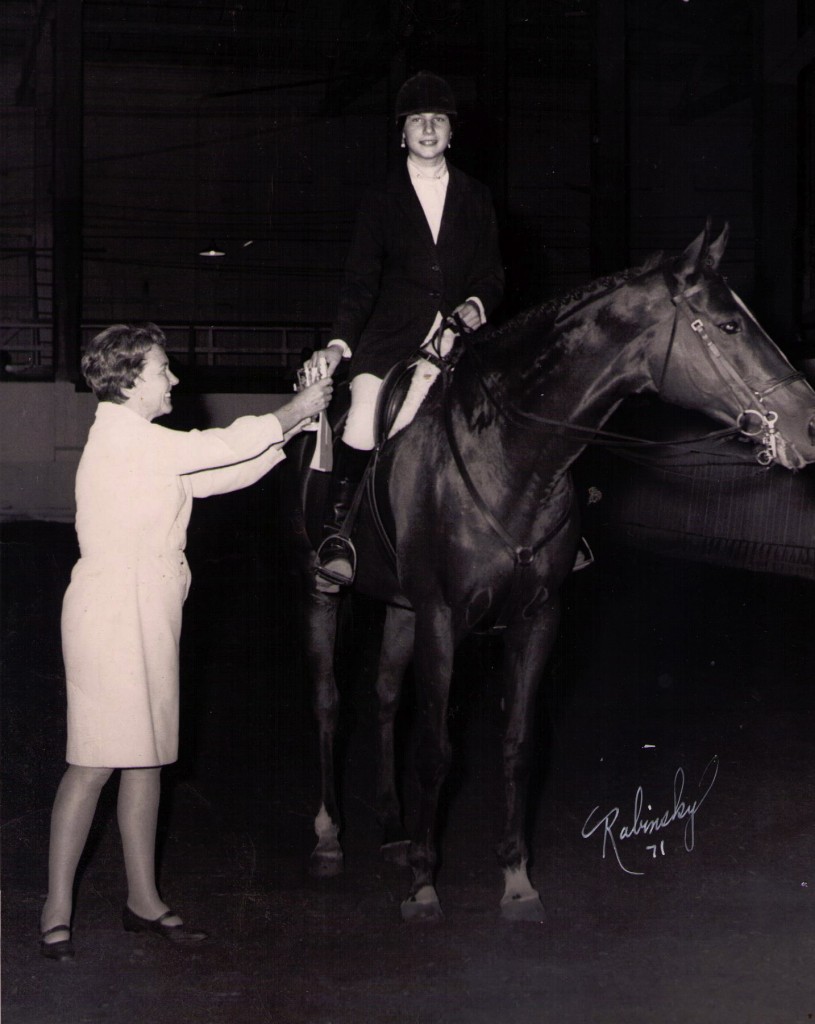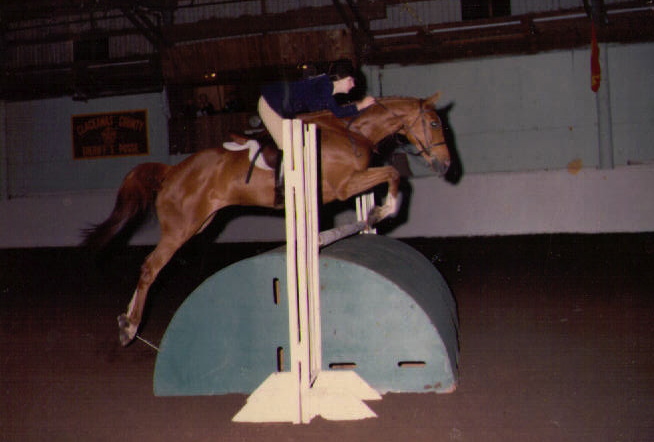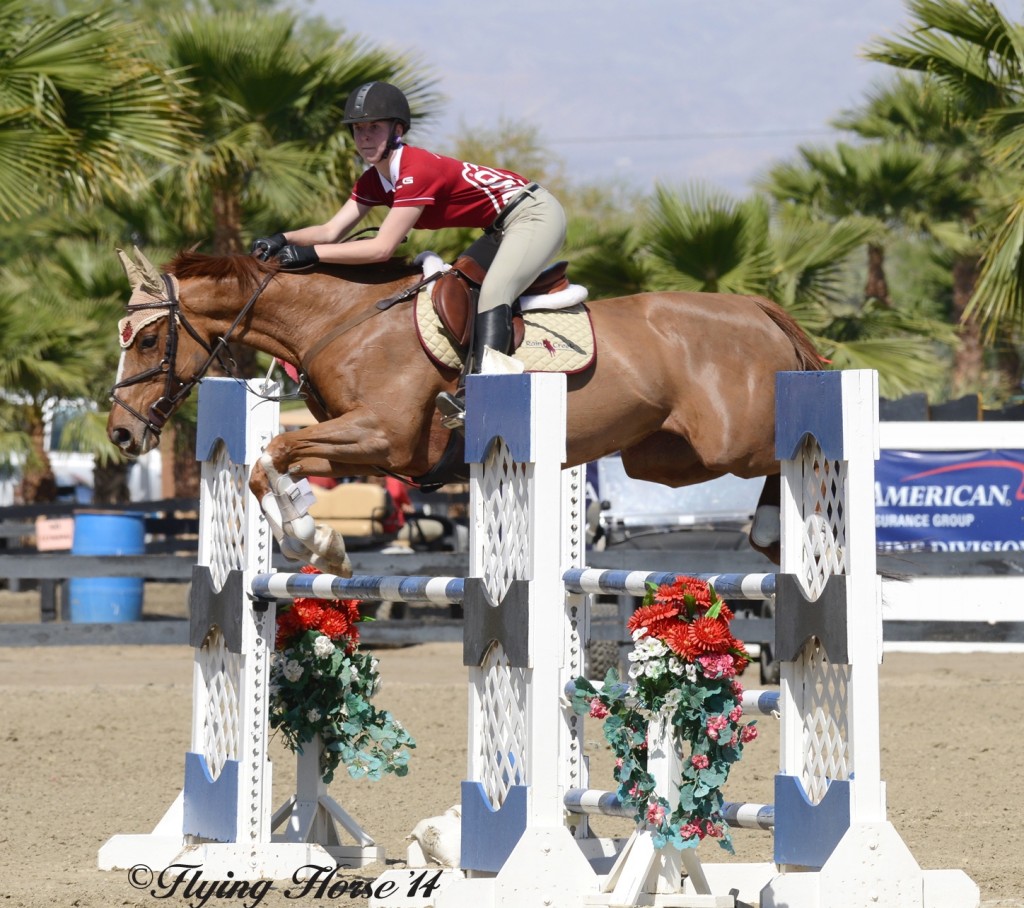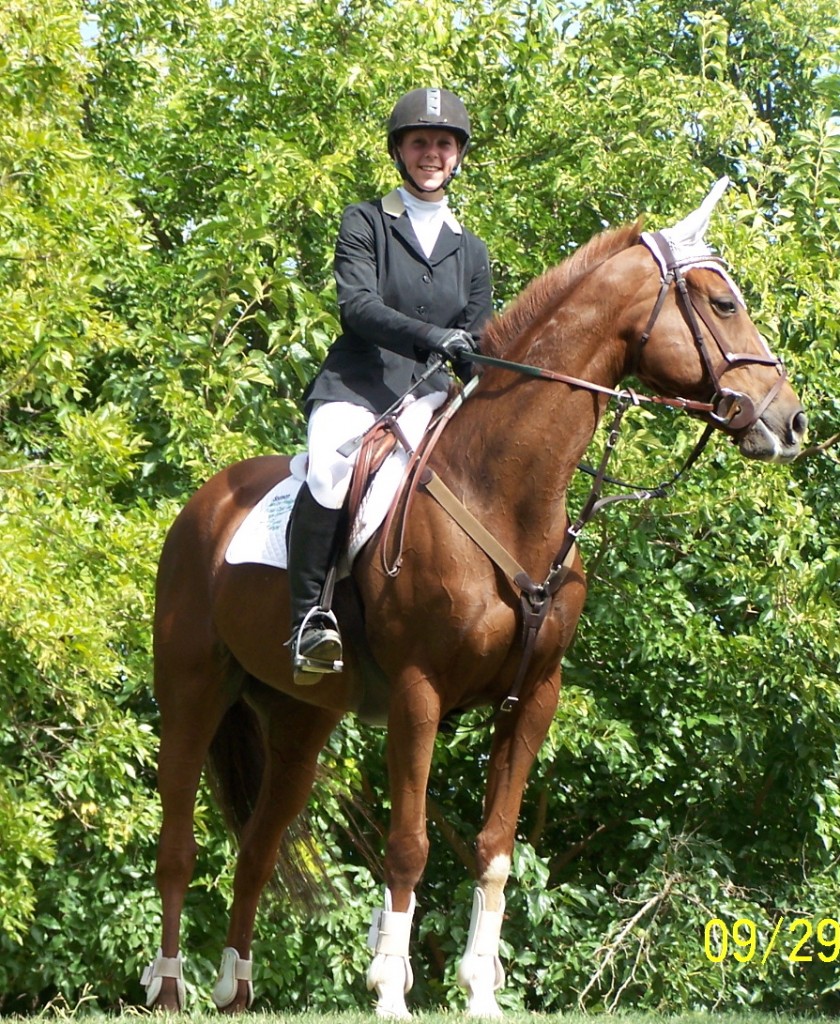
Vicki Zacharias, 14, on her first OTTB Scarlet Topi. This horse started her on the journey to teach others to ride hot Thoroughbreds.
Some say Vicki Zacharias tames fire-breathing dragons.
The self-taught equestrian who learned how to conduct herself on the backs of some pretty hot Thoroughbreds at the tender age of 12 says what she really does is train “children.”
The proprietor of Rain Creek Farms in Oregon has seen not just a few break-through moments between difficult horse and frustrated rider, including the powerhouse duo Holiday Cat and Brayle McEllrath, a pair who worked through many bucking and kicking episodes before winning their armful of ribbons. (Please see an earlier story on Holiday Cat).
In this week’s Clubhouse Q&A, Zacharias shares her philosophy and methods for riding difficult horses.
Q: You started your lifelong love of Thoroughbreds clinging to one on a training track.
I got my first Thoroughbred when I was 12. His registered name was Scarlet Topi. And the first time I rode him was on a training track. I was scared to death. But I fell in love with the horse. He has chips in his ankles and had run until he was 9. And, I rode him myself. We didn’t have the money to pay someone to ride him for me at first. I got him into Eventing, and he was extremely successful. I eventually sold him to a kid who rode him until he was 25.
Q: You pride yourself on your ability to bring difficult T-breds along. What’s your approach?
The number one thing you’ve got to remember is that they’re high-energy horses. They’ve been bred since the 1,700s to race. The other thing to remember is that they’re very smart. This makes them extremely fun to teach, but you have to be consistent in their training. If I choose something I want them to do, they need to understand it’s not okay if they don’t do it. It’s like raising children.
Q: For the naughty horse, you have what you term a Box of Discipline. What is that?
What this means is that I always make the punishment fit the crime. And I have certain basic rules of behavior they all must follow. For example, on the ground, I won’t let them walk on top of me and if I stop, they stop. When I ride them and I ask them to stop, go, or move off my leg, I expect them to at least try to understand to do that. If they shut me down, I will get a little cranky with them.
Q: Sometimes going in circles is good!
Turning them in a circle is an easy way to get them to learn to move off my right leg, like in a side pass. I try to keep things as simple as possible for them, again, like I would with a child.
Q: How do you channel the energy of a bucking horse into good behavior?
The first thing is, I don’t have fear. If a horse is bucking, I tend to channel my feelings into anger. I’ve been riding bad horses since I was a kid because we could never afford the good ones. And I’ve learned a few things. Like, if you’re on a bucking horse, you want to keep him moving forward because they’ll buck less hard if they’re going forward. I’ll also reach down and pull their head around and spank them with a stick.
I’ve found that if you can ride through a couple of bucks they’ll usually stop the behavior because it takes too much energy. Unless their bucks are due to pain-related reasons.
Another method I use, which I teach little kids, is the pull-rein. I teach them to plant one hand on the neck, and pull as hard as they can on the rein in the other hand. This should unbalance the horse enough to get their behavior to stop.
I had one who would bolt and then buck. If I thought he was going to do it, I’d lean as far back as I could and plant him on the ground like a flower. I learned how to use my core strength, and by planting my pelvis up against the pommel of my saddle, it was must harder for him to pull against me.
Q: Holiday Cat is one of your success stories. She was a temperamental mare who kicked and bucked. Please tell me about her. (Please see earlier article).
By the time I got Holiday Cat, her rider Brayle McEllrath had already worked with her a lot. She had no fear and she rode right through bad behavior. I watched this horse buck all the way up to the jumps.
It turned out that nobody had really said no. The first time she tried bucking to the jumps, I spanked her, and the first time she kicked at another horse, I spanked her for that too. After that, her behavior got a lot better as she understood that some behavior wasn’t acceptable.
All the mare wanted to do was jump the jumps—she loves it. So, if she acted up or bucked, I would back her up, smack her, and make her do things she didn’t necessarily want to do. I took all the emotion out of it. If she bucked or acted up, I’d say, ‘No, sorry, that’s not OK.’ And when she finally got it, I’d say, ‘That’s it! We can go jump now.’
But there are also some battles you don’t need to win. The mare always got excited going into the ring to do her job or coming out. So I told Brayle to step off, let her settle down, and then step back on. Rather than escalate the situation, it was better in this case to give her a moment to collect herself. And the mare soon figured it out.
I think with most difficult horses the most important thing is consistent discipline and work. They’ll come around eventually because horses like to follow the path of the least resistance. ♥
![]() If you enjoy stories like these, please consider visiting the blog’s new store, Off-Track Products. Proceeds will help sustain this blog in the future, and go to charity.
If you enjoy stories like these, please consider visiting the blog’s new store, Off-Track Products. Proceeds will help sustain this blog in the future, and go to charity.





Awesome tips. I have an OTTB mare and keep thinking I’m losing all the battles, but this makes me feel better.